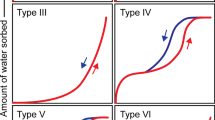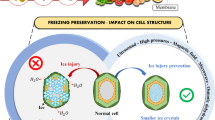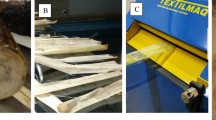Abstract
Main conclusion
Cell wall swelling, fracture mode (along the middle lamellae vs. across cell walls), stiffness, and pressure at fracture of the sweet cherry fruit skin are closely related.
Skin cracking is a common phenomenon in many crops bearing fleshy fruit. The objectives were to investigate relationships between the mode of fracture, the extent of cell wall swelling, and the mechanical properties of the fruit skin using sweet cherry (Prunus avium) as a model. Cracking was induced by incubating whole fruit in deionised water or by fracturing exocarp segments (ESs) in biaxial tensile tests. The fracture mode of epidermal cells was investigated by light microscopy. In biaxial tensile tests, the anticlinal cell walls of the ES fractured predominantly across the cell walls (rather than along) and showed no cell wall swelling. In contrast, fruit incubated in water fractured predominantly along the anticlinal epidermal cell walls and the cell walls were swollen. Swelling of cell walls also occurred when ESs were incubated in malic acid, in hypertonic solutions of sucrose, or in water. Compared to the untreated controls, these treatments resulted in more frequent fractures along the cell walls, lower pressures at fracture (p fracture), and lower moduli of elasticity (E, i.e., less stiff). Conversely, compared to the untreated controls, incubating the ES in CaCl2 and in high concentrations of ethanol resulted in thinner cell walls, in less frequent fractures along the cell walls, higher E and p fracture. Our study demonstrates that fracture mode, stiffness, and pressure at fracture are closely related to cell wall swelling. A number of other factors, including cultivar, ripening stage, turgor, CaCl2, and malic acid, exert their effects only indirectly, i.e., by affecting cell wall swelling.





Similar content being viewed by others
Abbreviations
- ES:
-
Exocarp segments
- E :
-
Modulus of elasticity
- p fracture :
-
Pressure at fracture
- ε fracture :
-
Strain at fracture
References
Atkinson RG, Sutherl PW, Johnston SL, Gunaseelan K, Hallett IC, Mitra D, Brummell DA, Schroder R, Johnston JW, Schaffer RJ (2012) Down-regulation of POLYGALACTURONASE1 alters firmness, tensile strength and water loss in apple (Malus × domestica) fruit. BMC Plant Biol 12:129. doi:10.1186/1471-2229-12-129
Bargel H, Spatz HC, Speck T, Neinhuis C (2004) Two-dimensional tension tests in plant biomechanics—sweet cherry fruit skin as a model system. Plant Biol 6:432–439
Barrett DM, Gonzalez C (1994) Activity of softening enzymes during cherry maturation. J Food Sci 59:574–577
Basanta FM, de Escalada Plá MF, Stortz CA, Rojas AM (2013) Chemical and functional properties of cell wall polymers from two cherry varieties at two developmental stages. Carbohyd Polym 92:830–841
Batisse C, Buret M, Coulomb PJ (1996) Biochemical differences in cell wall of cherry fruit between soft and crisp fruit. J Agric Food Chem 44:453–457
Brüggenwirth M, Knoche M (2016a) Factors affecting mechanical properties of the skin of sweet cherry fruit. J Am Soc Hort Sci 141:45–53
Brüggenwirth M, Knoche M (2016b) Mechanical properties of skin of sweet cherry fruit of differing susceptibilities to cracking. J Am Soc Hort Sci 141:162–168
Brüggenwirth M, Knoche M (2016c) Time to fracture and fracture strain are negatively related in sweet cherry fruit skin. J Am Soc Hort Sci 141:1–5
Brüggenwirth M, Fricke H, Knoche M (2014) Biaxial tensile tests identify epidermis and hypodermis as the main structural elements of sweet cherry skin. Ann Bot Plants 6:plu019. doi:10.1093/aobpla/plu019
Brummell DA (2006) Cell wall disassembly in ripening fruit. Funct Plant Biol 33:103–119
Brummell DA, Harpster MH (2001) Cell wall metabolism in fruit softening and quality and its manipulation in transgenic plants. Plant Mol Biol 47:311–340
Christensen JV (1996) Rain-induced cracking of sweet cherries. Its causes and prevention. In: Webster AD, Looney NE (eds) cherries. CAB International, Wallingford, pp 297–327
Chun JP, Huber DJ (1998) Polygalacturonase-mediated solubilization and depolymerization of pectic polymers in tomato fruit cell walls. Plant Physiol 117:1293–1299
Considine J, Brown K (1981) Physical aspects of fruit growth: theoretical analysis of distribution of surface growth forces in fruit in relation to cracking and splitting. Plant Physiol 68:371–376
Considine JA, Kriedemann PE (1972) Fruit splitting in grapes. Determination of the critical turgor pressure. Aust J Agr Res 23:17–24
De Belie N, Hallett IC, Harker FR, De Baerdemaeker J (2000) Influence of ripening and turgor on the tensile properties of pears: a microscopic study of cellular and tissue changes. J Am Soc Hort Sci 125:350–356
Demir T (2013) Determination of carotenoid, organic acid and sugar content in some sweet cherry cultivars grown in Sakarya, Turkey. J Food Agric Environ 11:73–75
Dumville JC, Fry SC (2003) Solubilisation of tomato fruit pectins by ascorbate: a possible non-enzymic mechanism of fruit softening. Planta 217:951–961
Glenn GM, Poovaiah BW (1989) Cuticular properties and postharvest calcium applications influence cracking of sweet cherries. J Am Soc Hort Sci 114:781–788
Grimm E, Knoche M (2015) Sweet cherry skin has a less negative osmotic potential than the flesh. J Am Soc Hort Sci 140:472–479
Grimm E, Peschel S, Becker T, Knoche M (2012) Stress and strain in the sweet cherry skin. J Am Soc Hort Sci 137:383–390
Ha M, Apperley DC, Jarvis MC (1997) Molecular rigidity in dry and hydrated onion cell walls. Plant Physiol 115:593–598
Hallett IC, MacRae EA, Wegrzyn TF (1992) Changes in kiwifruit cell wall ultrastructure and cell packing during postharvest ripening. Int J Plant Sci 153:49–60
Hansen M (2011) When is the best time to pick? Good Fruit Grower. http://www.goodfruit.com/when-is-the-best-time-to-pick/. Accessed 27 Sept 2016
Herrmann K (2001) Inhaltsstoffe von Obst und Gemüse. Ulmer, Stuttgart
Jarvis MC (1984) Structure and properties of pectin gels in plant cell walls. Plant Cell Environ 7:153–164
Jarvis MC (1991) Control of thickness of collenchyma cell walls by pectins. Planta 187:218–220
Jarvis MC, Briggs SPH, Knox JP (2003) Intercellular adhesion and cell separation in plants. Plant Cell Environ 26:977–989
Kerstiens G (1996) Barrier properties of the cuticle to water, solutes and pest and pathogen penetration in leaves of plants grown in polluted atmospheres. In: Yunus M, Iqbal M (eds) Plant response to air pollution. Wiley, Chichester, pp 167–178
Knoche M, Peschel S (2006) Water on the surface aggravates microscopic cracking of the sweet cherry fruit cuticle. J Am Soc Hort Sci 131:192–200
Knoche M, Beyer M, Peschel S, Oparlakov B, Bukovac MJ (2004) Changes in strain and deposition of cuticle in developing sweet cherry fruit. Physiol Plant 120:667–677
Knoche M, Grimm E, Schlegel HJ (2014) Mature sweet cherries have low turgor. J Am Soc Hort Sci 139:3–12
Kondo S, Danjo C (2001) Cell wall polysaccharide metabolism during fruit development in sweet cherry ‘Satohnishiki’ as affected by gibberellic acid. J Jpn Soc Hortic Sci 70:178–184
Levesque-Tremblay G, Pelloux J, Braybrook SA, Müller K (2015) Tuning of pectin methylesterification: consequences for cell wall biomechanics and development. Planta 242:791–811
McClendon JH (1981) The balance of forces generated by the water potential in the cell-wall-matrix: a model. Am J Bot 68:1263–1268
McGuire RG (1992) Reporting of objective color measurements. HortScience 27:1254–1255
Ng JKT, Schröder R, Sutherland PW, Hallet IC, Hall MI, Prakash R, Smith BG, Melton LD, Johnston JW (2013) Cell wall structures leading to cultivar differences in softening rates develop early during apple (Malus x domestica) fruit growth. BMC Plant Biol 13:183. doi:10.1186/1471-2229-13-183
Niklas KJ (1992) Plant biomechanics—an engineering approach to plant form and function. University of Chicago Press, Chicago
Oey ML, Vanstreels E, De Baerdemaeker J, Tijskens E, Ramon H, Hertog MLATM, Nicolai B (2007) Effect of turgor on micromechanical and structural properties of apple tissue: a quantitative analysis. Postharvest Biol Technol 44:240–247
Paniagua C, Pose S, Morris VJ, Kirby AR, Quesada MA, Mercado JA (2014) Fruit softening and pectin disassembly: an overview of nanostructural pectin modifications assessed by atomic force microscopy. Ann Bot 114:1375–1383
Peschel S, Knoche M (2005) Characterization of microcracks in the cuticle of developing sweet cherry fruit. J Am Soc Hort Sci 130:487–495
Quesada MA, Blanco-Portales R, Pose S, Garcia-Gago JA, Jimenez-Bermudez S, Munoz-Serrano A, Caballero JL, Pliego-Alfaro F, Mercado JA, Munoz-Blanco J (2009) Antisense downregulation of the FaPG1 gene reveals an unexpected central role for polygalacturonase in strawberry fruit softening. Plant Physiol 150:1022–1032
Redgwell RJ, MacRae E, Hallett I, Fischer M, Perry J, Harker R (1997a) In vivo and in vitro swelling of the cell walls during fruit ripening. Planta 203:162–173
Redgwell RJ, Fischer M, Kendal E, MacRae EA (1997b) Galactose loss and fruit ripening: high-molecular-weight arabinogalactans in the pectic polysaccharides of fruit cell walls. Planta 203:174–181
Roy S, Vian B, Roland J-C (1992) Immunocytochemical study of the deesterification patterns during cell wall autolysis in the ripening of cherry tomato. Plant Physiol Biochem 30:139–146
Roy S, Conway WS, Watada AE, Sams CE, Pooley CD, Wergin WP (1994) Distribution of the anionic sites in the cell wall of the apple fruit after calcium treatment. Protoplasma 178:156–167
Saladié M, Matas AJ, Isaacson T, Jenks MA, Goodwin SM, Niklas KJ, Xiaolin R, Labavitch JM, Shackel KA, Fernie AR, Lytovchenko A, O’Neill MA, Watkins CB, Rose JKC (2007) A reevaluation of the key factors that influence tomato fruit softening and integrity. Plant Physiol 144:1012–1028
Salato GS, Ponce NMA, Raffo MD, Vicente AR, Stortz CA (2013) Developmental changes in cell wall polysaccharide from sweet cherry (Prunus avium L.) cultivars with contrasting firmness. Postharvest Biol Technol 84:66–73
Schumann C, Schlegel HJ, Grimm E, Knoche M, Lang A (2014) Water potential and its components in developing sweet cherry. J Am Soc Hort Sci 139:349–355
Sénéchal F, Wattier C, Rusterucci C, Pelloux J (2014) Homogalacturonan-modifying enzymes: structure, expression, and roles in plants. J Exp Bot 65:5125–5160
Simon EW (1977) Leakage from fruit cells in water. J Exp Bot 28:1147–1152
Tibbits CW, MacDougall AJ, Ring SG (1998) Calcium binding and swelling behavior of a high methoxyl pectin gel. Carbohyd Res 310:101–107
Tieman DM, Handa AK (1994) Reduction in pectin methylesterase activity modifies tissue integrity and cation levels in ripening tomato (Lycopersicon esculentum Mill.) fruits. Plant Physiol 106:429–436
von Wetzhausen C (1819) Systematische Classification und Beschreibung der Kirschensorten. Friedrich Timotheus Heim (ed) Cottaische Buchhandlung, Stuttgard
Wada H, Shackel KA, Matthews MA (2008) Fruit ripening in Vitis vinifera: apoplastic solute accumulation accounts for pre-veraison turgor loss in berries. Planta 227:1351–1361
Wada H, Matthews MA, Shackel KA (2009) Seasonal pattern of apoplastic solute accumulation and loss of cell turgor during ripening of Vitis vinifera fruit under field conditions. J Exp Bot 60:1773–1781
Wen B, Ström A, Tasker A, West G, Tucker GA (2013) Effect of silencing the two major tomato fruit pectin methylesterase isoforms on cell wall pectin metabolism. Plant Biol 15:1025–1032
Winkler A, Ossenbrink M, Knoche M (2015) Malic acid promotes cracking of sweet cherry fruit. J Am Soc Hort Sci 140:280–287
Zamil MS, Hojae Y, Puri VM (2014) Mechanical characterization of outer epidermal middle lamella of onion under tensile loading. Am J Bot 101:778–787
Zamil MS, Hojae Y, Puri VM (2015) The mechanical properties of plant cell walls soft material at the subcellular scale: the implications of water and of the intercellular boundaries. J Mater Sci 50:6608–6623
Acknowledgements
We thank Dieter Reese and Christoph Knake for constructing, engineering, and programming the elastometer; Simon Sitzenstock for technical support; Sandy Lang and Andreas Winkler for helpful discussion and useful comments on an earlier version of this manuscript. This study was funded in part by a grant from the German Science Foundation (DFG).
Author information
Authors and Affiliations
Corresponding author
Ethics declarations
Conflict of interest
The authors declare that they have no conflict of interest.
Rights and permissions
About this article
Cite this article
Brüggenwirth, M., Knoche, M. Cell wall swelling, fracture mode, and the mechanical properties of cherry fruit skins are closely related. Planta 245, 765–777 (2017). https://doi.org/10.1007/s00425-016-2639-7
Received:
Accepted:
Published:
Issue Date:
DOI: https://doi.org/10.1007/s00425-016-2639-7




